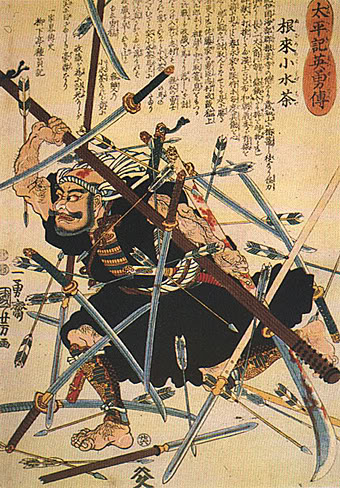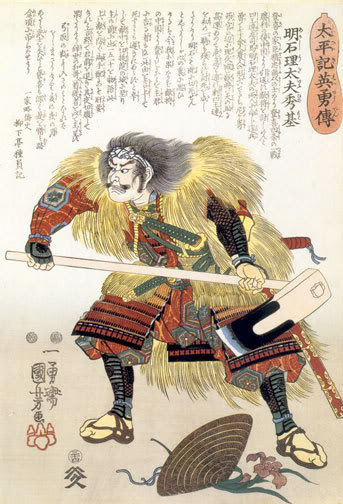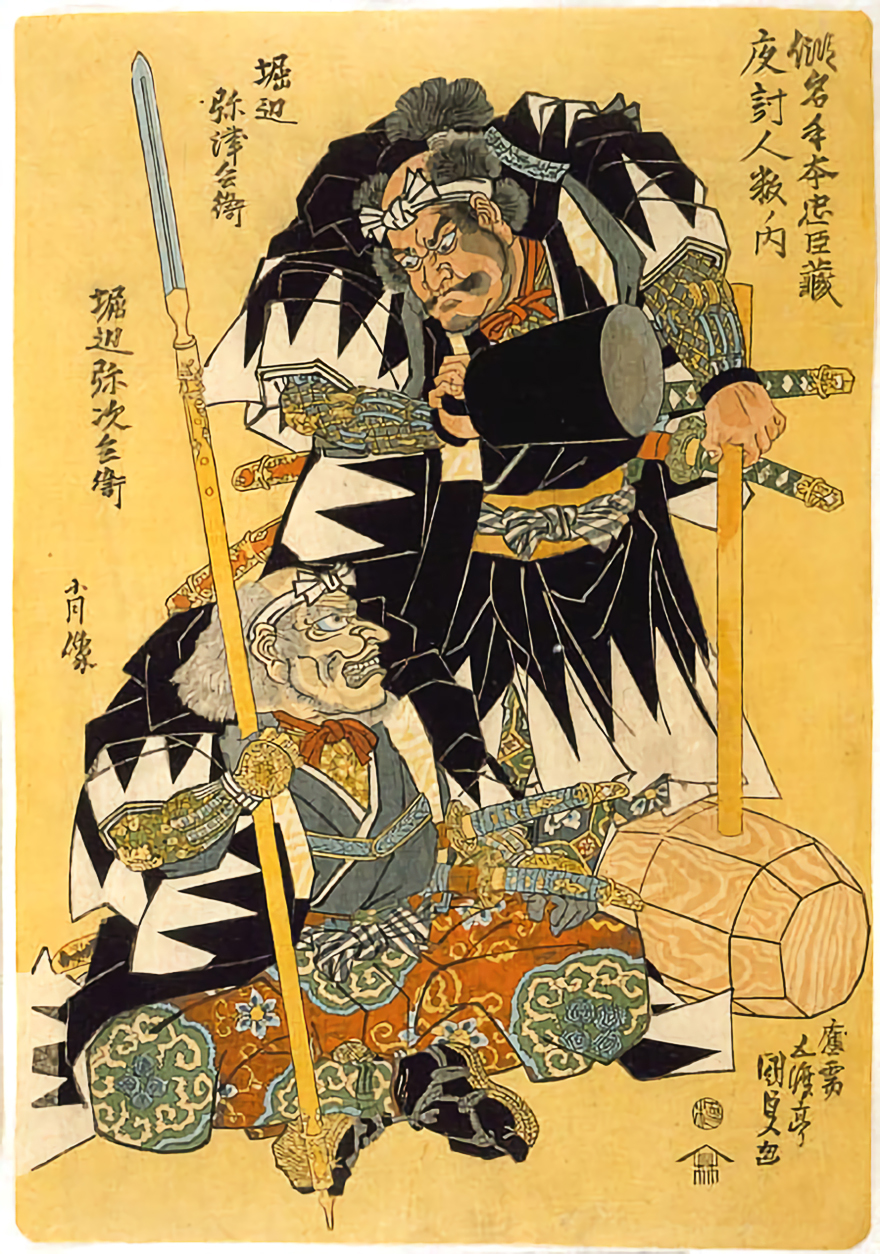| Author |
Message |
|
Timo Nieminen
|
 Posted: Wed 30 Nov, 2011 12:44 am Post subject: Posted: Wed 30 Nov, 2011 12:44 am Post subject: |
 |
|
| Eric S wrote: | | Timo Nieminen wrote: | | William P wrote: |
secondly on the topic of japanese weapons... that axe... http://en.wikipedia.org/wiki/File:Ono_1.JPG is that a woodsmans axe, or a war axe? or was it the sort of thing that concievably could be used for both purposes. |
Neither; that's a carpenter's axe. They're still used today, and you can buy new ones. These ones are usually 30-40cm long overall (12-16" for non-metric readers). They vary in size a lot, so the one in the photo could be larger. Sometimes there is enough space to fit the fingers between the haft and the beard, so it can be gripped behind the head, but sometimes the beard is almost flush against the haft. |
I suppose that this guy is a simple carpenter? |
You will notice that that isn't the same kind of axe.
Just as a large butcher's knife is not a sword, and a sword isn't a large butcher's knife, a battle axe is not the same as a carpenter's axe. For an introduction to Japanese woodworking axes, see http://www.dougukan.jp/contents-en/modules/tinyd8/index.php?id=24 .
"In addition to being efficient, all pole arms were quite nice to look at." - Cherney Berg, A hideous history of weapons, Collier 1963.
|
|
   |
 |
|
William P
|
 Posted: Wed 30 Nov, 2011 1:26 am Post subject: Posted: Wed 30 Nov, 2011 1:26 am Post subject: |
 |
|
| Eric S wrote: | | William P wrote: |
so were those sai you have photgraphed okinawan sai or were they from mainand japan?
secondly on the topic of japanese weapons... that axe... http://en.wikipedia.org/wiki/File:Ono_1.JPG is that a woodsmans axe, or a war axe? or was it the sort of thing that concievably could be used for both purposes.
whats also interesting is that tyetcubo, featuring the wooden pole studded with rivets, weighing 4 pounds is VERY reasonable for something like that, to contrast, my danish axe weighs 1.7kg (3.5 pounds) and it handles fine, theyre both the same length, i dont think 500 grams extra would be that much of a hassle, |
William, The smaller sai is from Indonesia and it is called a "tjabang" or "chabang" the larger one I have labeled as being Okinawan (in style) even though it came from mainland Japan. The large one is quite thick and heavy, the Japanese seemed to prefer a lighter type of truncheon, most jutte I see while similar to sai are actually quite light.
As for the kanabo/tetsubo, at 4.8ft and 4lbs its heavy enough, I had always read about weapons like the kanabo being much heaver but when you actually swing one you soon realize how difficult it would be to swing a very long and heavy club with any accuracy.
As for the ono (axe), I have seen several old Japanese prints showing ono being carried or used by samurai, and while its certainly possible that any ono used in battle were just re-purposed working axe they would still be effective as a weapon.

kanabo/tetsubo
 |
i apologize but i feel extremely sceptical about that first woodcut showng that man sized axe, considering the head is shown as being bigger than the guys head, i feel sceptical that its a practical weapon,
as for the kanabo, that 4 lb example is manageable, it depends on how you use it.. it will be unwieldy if you hold it as you would a katana, both hands nearest one end and close apart, you will get the greatest momentum out of it though. but if you hold it more like you would a naginata or bo staff, either both hands close to the middle, or one hand on the butt and the other much further up the shaft, to the head,thats how its managable.
those big full blooded swings with ahnds both near the butt end, will be for finishing blows on unsuspecting or mostly downed opponents, but mostly id use it one hand halfway up the shaft, the other near the butt, this lets you have a more efficiant leverage arrangement.
4 pounds is still pretty freaking heavy though...
and anything heavier than 5 pounds is getting into the realm of bloody ridiculous. most german zweihanders i think were sometimes heavier than this weapon.
|
|
   |
 |
Eric S

|
 Posted: Wed 30 Nov, 2011 1:35 am Post subject: Posted: Wed 30 Nov, 2011 1:35 am Post subject: |
 |
|
| Timo Nieminen wrote: |
You will notice that that isn't the same kind of axe.
|
Im not seeing significant differences, maybe I am missing something. In prints the ono pictured are supposed to represent a weapon that is quite a bit older that the more modern ones you can find images of, look at the armor here, pre 1500s.

|
|
   |
 |
|
William P
|
 Posted: Wed 30 Nov, 2011 2:05 am Post subject: Posted: Wed 30 Nov, 2011 2:05 am Post subject: |
 |
|
that one looks abit more practical, but still, its huge and still looks hellishly heavy
im wondering why NONE of these axes ever look to be a normal in size and dimensions and i say that wt a practical upshot as well, since its those historical, and more normal axes are the ones actually able to be wielded with any amount of skill or control.
throughout history and the planet, no 2 handed axes were that big in terms of the size of the head, its simply overkill. its also got a steady wedge profile...
the odd thing is that all the other weapons are drawn as regular size.
|
|
   |
 |
Eric S

|
 Posted: Wed 30 Nov, 2011 2:16 am Post subject: Posted: Wed 30 Nov, 2011 2:16 am Post subject: |
 |
|
| William P wrote: | that one looks abit more practical, but still, its huge and still looks hellishly heavy
im wondering why NONE of these axes ever look to be a normal in size and dimensions and i say that wt a practical upshot as well, since its those historical, and more normal axes are the ones actually able to be wielded with any amount of skill or control.
throughout history and the planet, no 2 handed axes were that big in terms of the size of the head, its simply overkill. its also got a steady wedge profile...
the odd thing is that all the other weapons are drawn as regular size. |
William, the artist was just messing with us, it is not unusual for Japanese artist to draw some aspect of a print out of context, they did quite often picture samurai fighting demons etc, also while swords and other weapons were quite commonly seen and most people were familiar with their actual dimensions it may have been a different thing with some more obscure weapon such as ono, kanabo or otsuchi (war mallet). Now would this be a garden hoe or a war hoe?

Otsuchi (war mallet).

|
|
   |
 |
|
Timo Nieminen
|
 Posted: Thu 01 Dec, 2011 1:01 pm Post subject: Posted: Thu 01 Dec, 2011 1:01 pm Post subject: |
 |
|
| Eric S wrote: | | Timo Nieminen wrote: |
You will notice that that isn't the same kind of axe.
|
Im not seeing significant differences, maybe I am missing something. |
The various Japanese carpentry axes have well-established designs. They all have their individual names. Each one is made for a specific use (or range of specific uses). If you see an axe that is clearly one of these standard designs, you know that it is a carpentry axe, not a tree-felling axe or a battleaxe.
A similar situation exists for kitchen knives, which are usually of stereotypical design.
The original axe (the photo) is a stereotypical carpentry axe, and therefore, is almost certainly a carpentry axe. The drawing shows an axe that isn't a stereotypical carpentry axe. The axe in the drawing is also not the size of a carpentry axe. That the drawing shows a warrior with an axe says nothing towards the axe in the photo being anything other than a carpentry axe.
That the axe in the photo is a carpentry axe says nothing against the use of axes in warfare, any more than a picture of a kitchen knife would say anything against the use of swords and messers in war and other fighting. The axe in the 2nd drawing has the full set of fittings expected on a battleaxe, and is a stereotypical Japanese battleaxe. The one in the 1st drawing has no fittings, just a bare haft - I don't know how realistic this is.
"In addition to being efficient, all pole arms were quite nice to look at." - Cherney Berg, A hideous history of weapons, Collier 1963.
|
|
   |
 |
|
|
You cannot post new topics in this forum
You cannot reply to topics in this forum
You cannot edit your posts in this forum
You cannot delete your posts in this forum
You cannot vote in polls in this forum
You cannot attach files in this forum
You can download files in this forum
|
All contents © Copyright 2003-2024 myArmoury.com — All rights reserved
Discussion forums powered by phpBB © The phpBB Group
Switch to the Basic Low-bandwidth Version of the forum
|

